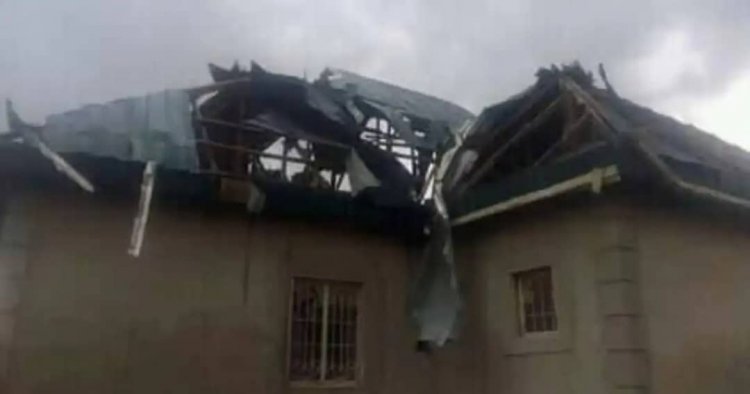The rate at which storms sabotage and remove buildings is increasing by the day and it is quite alarming and staggering. The storms have been a nightmare for residential buildings in Nigeria and around the world. He has been manipulating the existence of buildings and it has been a harmful act. The negative impact of storms can never be overstated or underestimated when talking about buildings in Nigeria in general.
The storm causes a multitude of different damage scenarios in the current situation. It is a devastating fact for the building.
Rainstorms can be described simply as the deluge or barrage of rainfall characterized by thunderstorms. Storms can be said to distort and deform the foundation and shape of a building.
Research has shown that the impacts of rainstorms on buildings in urban areas are often extensive. In general, the negative consequences of this environmental risk compared to storms or hail events are often underestimated. Additionally, the intensification of excessive weather events due to climate change, including the increased physical susceptibility of assets, will lead to increased impacts on the built environment.
Rainstorms are highly localized, making prudent assessment of their probability and severity difficult, as available rain gauges may not have reliably sampled the heaviest rainfall. Heavy rain and storms affect buildings directly and indirectly.
In recent times, engineering studies have shown the variety and high physical susceptibility of building constructions that are constantly affected by water invasion during heavy rains that cause storms and that are; flat roofs, rooftops and balconies, underground parking decks covered with earth, the connections between steep roofs and other parts of the building, basement walls in contact with the ground and bottom plates, including windows and exterior doors.
It is pertinent that most damage is avoidable if exposed constructions become more flexible. Any retrofit requires experience in demanding damage processes to examine insufficiencies and decrease the physical susceptibility of building constructions exposed to heavy storms.
A rainstorm can result in urban pluvial flooding due to sewage overflow that causes damage to buildings. A comprehensive study of the impacts and consequences in the city of Dresden (Germany) revealed that the risks of sewer flooding due to hydraulic overloading can be estimated at the building scale using the IVART (Integrated Spatial Vulnerability and Risk Assessment Tool) modeling approach. ) .
The results from the Commonwealth of Nations provide the basis for estimating the effectiveness and efficiency of flood resiliency technologies.
Global climate change is measurable, and projections of its possible regional impacts are crucial for modification planning. It is pertinent that the probability and severity of dangerous storms have increased in European regions in the last 40 years (Grieser and Beck 2002).
The negative impact of a storm is virtually dependent on the physical susceptibility of buildings, that is, the number of exposed materials and structures (eg, roofs, facades) to be disruptive and damaged.
Storm impacts are challenging the retrofit of existing buildings, the prerequisites for developing a suitable retrofit measure is to explore the impact in detail.
Typical damage profiles caused by heavy rain include moisture penetration, water spots, and efflorescence on internal building elements, as well as water ingress through the building structure. These are often accompanied by damage to the structure of buildings.

Storm Precautions
The following measures can be implemented to avoid storms in Nigeria.
Gutters and Downspouts.
It is important and crucial to have a well-functioning gutter system to prevent rain from entering the building or damaging the building’s foundation. The gutters must be clean to avoid obstructions and water overflows. There are several products that can be used to maintain gutters and make them free of debris.
The gutters are seen as the go-between from the roof to the ground, preventing rainwater from running down the walls of the building. You can target downspouts away from the building’s foundation and direct the water into a garden or vegetation. Clean gutters and proper use of downspouts will definitely keep your building’s foundation intact no matter the level of storms.
Roof inspection
The roof is obviously the first line of defense against most weather conditions, especially storms. The roof should be properly monitored and inspected for loose shingles, soft spots, and surface indentations. A crack in the ceiling can lead to a roof leak and then further internal damage to the walls and ceilings.
Solid foundation
A strong foundation is key to keeping stormwater runoff off the building’s foundation. The ground on which the building is surrounded should slope downward away from the foundation. It is advisable to have at least five feet of downslope to achieve the maximum benefit of avoiding runoff damage.
When rainwater pools around buildings, the water seeps into the ground and can crack foundations. Once the cracks form, water can seep in and make the basement damp or wet. Dampness in the basement will attract mold and mildew, along with termites and carpenter ants. These mishaps can be prevented by properly keeping water away from the building.
Rainwater collection system
The installation of a rainwater harvesting system is another option for rain management. Rainwater flows from the gutter, travels through the downspout, and reaches the tank or barrel. Rainwater can be reshaped for irrigation or for seasonal purposes. Rainwater collectors vary depending on what you need them for.
Water damage is one of the costliest damage to a building. If not treated immediately, it will have serious long-term damage that could need major repairs, if not replaced entirely.
It is highly recommended to stay prepared and avoid water damage before it is too late.








